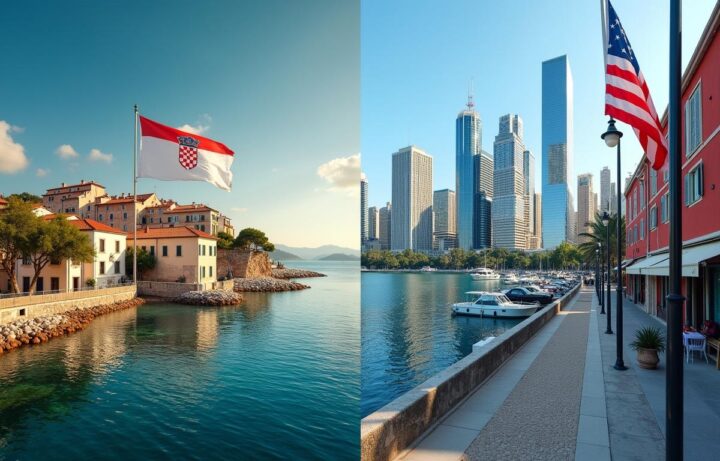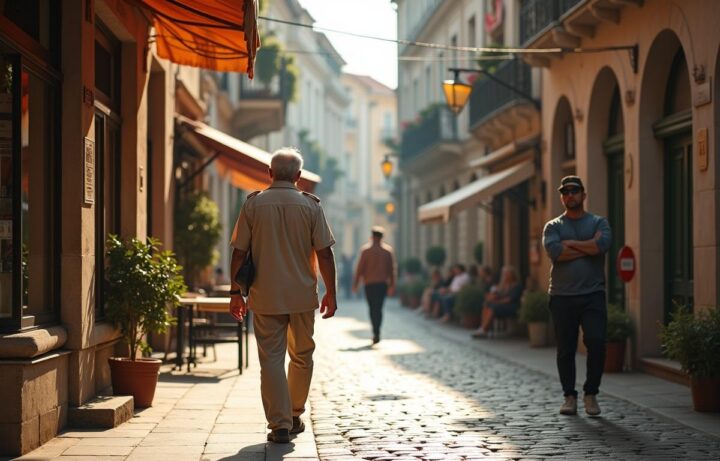Why Croatia’s Living Costs Shocked Me
Many travelers and expats get a shock from the cost of living in Croatia because they expect Eastern European bargain prices. The country stands as Eastern Europe’s second most expensive nation and costs more than 63% of countries worldwide. A family of four needs €3,529 monthly to live comfortably, while a single person must budget around €1,667.

The numbers look better compared to American prices, with rent costing 59.3% less than in the USA. The cost of living still catches newcomers off guard, especially when they have to deal with recent price hikes. Prices jumped 4.5% in 2024, and suppliers have announced another 3% increase for 2025. The financial picture becomes clearer by comparing Croatia with Thailand and other expat hotspots that attract retirees seeking affordable European living. The average monthly net salary sits at €1,326.30, which creates a tough financial situation for both locals and expatriates.
The First Shock: Croatia Cost of Living Basics
Tourists often feel their jaws drop when they see their first restaurant bill or grocery receipt in Croatia. The country’s cost of living might seem reasonable at first glance, but a closer look reveals a different reality.
Cost of Living Croatia: First Impressions
Many visitors arrive with euros in hand, only to learn that Croatia stands as the 52nd most expensive country worldwide according to the 2025 Cost of Living Index. The country is nowhere near a budget-friendly Eastern European destination. Since Croatia switched to the euro in 2023, living costs have steadily risen.
Understanding everyday expenses is vital for tourists and expats. A family of four needs about €3,003.60 monthly (without rent), while a single person spends roughly €859 on basic needs. A typical apartment’s monthly utilities run about €164.54, covering electricity, heating, cooling, water, and garbage collection.
The food prices might catch you off guard. A basic restaurant meal costs around €12, and a nice dinner for two at a mid-range place runs about €60. Grocery prices won’t save you much money either – milk costs €1.10 per liter, eggs are €3.21 per dozen, and local cheese sells for about €9.85 per kilogram.
On top of that, transportation costs add up. A monthly public transport pass runs approximately €46.50, and gas prices hover around €1.53 per liter. Rent has shot up too, with city center one-bedroom apartments averaging €650.75 monthly.
Cost of Living in Croatia vs USA: A Quick Glance
The cost differences between Croatia and the USA tell an interesting story. Croatian consumer prices, including rent, sit 59.9% below U.S. levels. This gap makes Croatia attractive to Americans who want European living without the hefty U.S. price tag.
All the same, some costs show unexpected patterns. Rent prices fall 145.9% below U.S. rates, while groceries cost 61.3% less. Croatian restaurants charge just 32.9% less than their American counterparts.
The salary gap paints an even clearer picture. Croatians take home about €1,326.30 after taxes, while in Thailand, both wages and living costs run lower. Americans earn roughly €3,813.18 monthly – almost three times more than Croatians.
Anyone thinking about retirement or moving to Croatia long-term should look at these numbers carefully. Living comfortably in Croatia requires about €1,500-€2,000 monthly for one person. While Croatia offers better value than expensive countries like New Zealand, it’s not the bargain paradise some might expect.
Recent inflation trends deserve attention. Croatia saw prices jump 4.5% in 2024, and over 50 suppliers announced 3% increases for 2025. These changes mean both visitors and residents need to adjust their budgets as Croatia’s cost landscape continues to shift.

Rent and Housing: Why It Hit Harder than Expected
My biggest shock about Croatia’s cost of living came from housing expenses. After moving into my Croatian apartment, I found that there was a much bigger chunk of my budget going to accommodation than I’d originally planned.
Average Cost of Apartments in 2025
The Croatian real estate market keeps climbing in 2025. The Croatian Bureau of Statistics shows property prices jumped 10.1% in late 2024 compared to the previous year. This upward trend hasn’t stopped since 2017, with prices going up 8-12% each year.
You’ll see huge differences in Croatia’s living costs just by looking at housing prices across regions. The Adriatic Coast saw home prices shoot up by 16% in 2024, while Zagreb had a smaller increase of 7.7%. New apartments in Zagreb now cost between €2,800-3,500 per square meter.
A one-bedroom apartment in city centers costs about €650.75 monthly, while similar places outside central areas run around €498.58. Families who need more space will pay about €1,084.38 monthly for three-bedroom apartments in city centers, or €798.66 outside.
Location makes these prices swing wildly. Dubrovnik and Split charge premium rates of €100-150 per night during high season for short stays. Cities like Zadar and Rijeka are cheaper at €50-80 per night.
Hidden Costs when Renting in Croatia
My Croatian housing budget got hit by several surprise expenses. These hidden costs make a big difference in actual living expenses compared to Thailand.
Tenants pay more than just rent. There’s “pricuva” (reserve) – a required building maintenance fee of about €0.36 per square meter. This pays for elevator upkeep, common area power, and building fixes.
Utilities take another big bite from your wallet. A standard apartment’s basic services (electricity, heating, cooling, water, garbage) typically run €164.54 monthly. Internet service adds another €27.73 monthly.
Anyone thinking about retiring in Croatia should factor in regular maintenance costs. Painters charge €15-25 hourly, and plumbers and electricians cost about the same for repairs. These small costs add up fast.
Red tape makes things more complex. Anyone from abroad who rents for more than 90 days must register with local authorities. Landlords must pay taxes on rental income, and knowing these rules is vital for lease negotiations.
Buying Property vs Renting: What I learned
I found some surprising facts about owning property in Croatia after crunching the numbers for both options. The math isn’t simple for singles or couples.
Buying real estate costs more than just the purchase price. You’ll pay a 3% real estate transfer tax on the property’s market value. Owners also face ongoing costs like utilities, insurance, and maintenance.
Croatia is different from other countries – there’s no property tax except for holiday homeowners. Still, if you rent out your property, you’ll pay income tax. Starting 2025, new tax rules target vacation rentals specifically.
Getting a mortgage comes with its own hurdles. Croatia’s 20-year fixed-rate mortgages average 4.32%, which is higher than Western Europe. This financing cost gap really affects overall affordability compared to New Zealand’s living expenses.
Croatian banks are tough on lending, especially with non-EU citizens. They’ll usually only approve housing loans up to 30-35% of monthly income. This makes buying property tough since the average Croatian monthly net salary sits at €1,326.30.
Foreign investors still like the market despite these challenges. Croatia’s tourism potential keeps driving property demand, and coastal investment opportunities keep growing.

Food and Groceries: Not as Cheap as I Thought
My grocery bags felt lighter but my wallet took a bigger hit after my first shopping trip in Croatia. Living costs here, especially food expenses, turned out to be one of the biggest surprises after moving to this beautiful Mediterranean country.
Grocery Shopping Surprises
Food prices in Croatia have shot up over the last several years. Food inflation reached 4.70% in March 2025 compared to the previous year. The government tried to control prices by introducing restrictions on 70 common supermarket items like bread, pork, and shampoo in February 2023.
A quick look at a typical grocery basket shows why living costs catch people off guard here. A loaf of fresh white bread costs around €1.27, a dozen eggs about €3.21, and a kilogram of local cheese approximately €4.48. These prices are higher than what you’d expect from an Eastern European destination.
The markets across Croatia show clear price differences. Prices peak in coastal areas during tourist season. Zagreb and other inland cities are a bit cheaper, but they’re nowhere near the bargains that travelers expect in their budget calculations.
Eating Out: Croatia Cost of Living Reality
Restaurant prices paint another picture of the financial reality. You’ll pay around €12 per person at a basic restaurant, while a three-course dinner for two at a mid-range place costs about €60. Even a simple cappuccino sets you back €2.14 on average.
The coastal areas hit your wallet hardest. Dubrovnik restaurants charge €20-50 per person for lunch and between €60-100 for a traditional dinner with wine. A single cocktail in a downtown club runs about €12.
Life in Croatia needs careful budgeting. Someone who cooks at home should set aside around €300 monthly for groceries. Couples typically spend about €400 monthly on food, and this jumps up if you buy imported or specialty items.
Compared with Thailand: Food Prices Shock
The difference between Croatian and Thai food prices comes as the biggest surprise. Thai prices are much lower, making Croatia’s food costs feel like a shock to the system.
Restaurants show the biggest gap – eating out in Croatia costs 128.4% more than Thailand. A basic restaurant meal in Thailand costs just €2.62 compared to Croatia’s €12.
Some grocery items tell a different story. Milk (30.8% cheaper in Croatia), local cheese (34.2% cheaper), and apples (41.5% cheaper) cost less in Croatia than Thailand. But chicken filets (238.7% more expensive), rice (141.8% more), and water (136.6% more) are a big deal as it means that Croatian prices are much higher.
These differences matter a lot to retirement planning. A family in Croatia needs about €750-800 monthly for food. This makes food costs crucial when comparing living expenses between Italy, Croatia, or other retirement options.
Transportation and Daily Life Expenses
My daily commute in Croatia taught me about a big part of living costs that many overlook. The reality of getting around costs more than most digital nomads expect, compared to costs in Portugal.
Public Transport vs Owning A Car
Transportation costs in Croatia create an interesting scenario. The public transport system offers good value. A one-way ticket in Zagreb costs between €0.53-1.33 for 30-90 minute rides. Regular commuters can benefit from monthly passes that cost €46.50 on average nationwide.
Car ownership costs are a big deal as it means that you’ll need deeper pockets. A car’s registration alone costs €200-650 yearly based on the vehicle’s type and age. Budget cars around €5,000 (10 years old) need about €2,000 yearly to cover maintenance, insurance, fuel, and registration. Gas prices hover between €1.40-1.86 per liter. This makes fuel expenses a key factor in anyone’s monthly budget planning.
Modest driving of about 6,700 km yearly leads to fuel costs exceeding €750. Technical inspections add another €50-100 to yearly expenses.
Living Expenses in New Zealand vs Croatia: A Quick Note
New Zealand’s living costs exceed Croatia’s by 22.5% with rent included. Transportation costs 20.9% more in New Zealand. Public transit monthly passes cost 75.3% more than Croatia’s.
Croatian vehicle owners spend about two months of their yearly salary on car-related expenses. This creates a bigger dent in the budget than similar costs in Thailand or other expat hotspots.
Unexpected Daily Costs that Add Up
Hidden expenses can affect your total living costs in Croatia. Island hopping by ferry costs €3.20-8.40 per person. Car ferries cost between €12-43. These expenses matter especially when planning retirement in coastal areas.
Intercity bus travel adds another expense to consider. Zagreb to Split trips cost €18-25, while Zagreb to Dubrovnik routes cost €23-30. Tourist season requires advance booking since busses fill up quickly.
Transportation costs in Croatia remain lower than USA prices. Yet, knowing these details helps avoid financial surprises when moving to this Mediterranean gem.
Healthcare, Entertainment, and Lifestyle Costs
Healthcare and entertainment are vital yet often overlooked parts of Croatia’s living costs. After moving into my Croatian apartment, I learned these expenses could substantially affect your budget.
Healthcare Costs for A Single Person
Croatia’s healthcare system works on a two-tier structure. Residents must register with HZZO (Croatian Health Insurance Fund), which costs about €90-100 monthly if you don’t have a job. People with jobs contribute 16.5% of their bruto salary toward health insurance.
Croatian healthcare differs from the US system because it needs co-payments. You’ll pay €1.32 for a doctor’s visit and €17.70 daily for hospital stays. The good news is co-payments have a maximum cap of €530.88 per treatment. Most people get supplemental insurance (dopunsko) to avoid these co-payments.
Private healthcare insurance costs between €50-150 monthly for one person. A visit to a private doctor costs €40-80, while a quick 15-minute consultation runs about €50.
Entertainment and Gym Memberships
Life in Croatia goes beyond just the basics. Gym costs vary across locations – you can pay €26.50 monthly at Gyms4You with a year’s contract or up to €78 in business areas.
Entertainment costs less here than in Thailand. A movie ticket sets you back €7.50, and theater shows start at €15. A simple dinner for two at a local pub costs about €46, while a nice Italian dinner with wine runs around €78.
Retirement Planning: Is Croatia Still Affordable?
The numbers matter even more when you look at retiring in Croatia. You need about €1,500-2,000 monthly to live comfortably. This amount covers your healthcare, entertainment, and daily needs.
Living costs used to be much lower than in New Zealand. Since Croatia switched to the euro in 2023, prices have gone up. The cost of living here remains 26.6% lower than in the United States, which makes Croatia a good option for retirement.
Cost of Living in Croatia Frequently Asked Question
What is the Average Monthly Cost of Living for A Family in Croatia?
According to recent data, a family of four needs approximately €3,529 per month to maintain a comfortable lifestyle in Croatia. This amount covers basic expenses such as housing, food, transportation, and healthcare.
Has Croatia Become More Expensive for Tourists in Recent Years?
Yes, Croatia has seen a significant increase in tourism prices. Over the past three years, prices have risen by about 50%, making it more expensive than some other Mediterranean destinations like Greece and Spain.
Is €1000 Enough for Monthly Expenses in Croatia?
While €1000 might cover basic expenses for a single person in some areas, it may not be sufficient for comfortable living in major cities. In Zagreb, for example, rent alone for a standard apartment can cost around €1000 per month.
How Much Should a Single Person Budget for Comfortable Living in Croatia?
A single person should budget approximately €1,500 to €2,000 per month for comfortable living in Croatia. This amount would cover rent, food, utilities, healthcare, and some entertainment expenses.
How Does Croatia’s Cost of Living Compare to Western Countries?
Croatia’s cost of living is generally lower than in Western countries, but higher than many Eastern European nations. Consumer prices, including rent, are about 59.9% lower than in the United States, making Croatia an attractive option for many expatriates and retirees.
What Are the Main Factors Influencing Living Costs in Croatia?
Living costs in Croatia are influenced by location, lifestyle, and seasonality. Coastal cities like Dubrovnik and Split tend to be more expensive, especially during tourist season, while inland areas such as Osijek or Slavonski Brod offer more affordable living. Additionally, imported goods and utilities can increase overall expenses.
Are Utilities and Internet Expensive in Croatia?
Utilities in Croatia for an average-sized apartment typically cost between €150 and €250 per month, including electricity, heating, water, and garbage. High-speed internet plans are widely available and cost around €25 to €35 monthly, depending on the provider and package.
How Affordable is Healthcare in Croatia for Expats?
Croatia offers a public healthcare system that is accessible to residents and registered expats. Monthly contributions to the public system range from €50 to €70. Private healthcare is also available, with specialist visits typically costing €30 to €70, making it relatively affordable compared to Western Europe or the U.S.
Is Dining Out in Croatia Expensive?
Dining out in Croatia can be quite affordable, especially in smaller towns. A meal at a mid-range restaurant typically costs between €10 and €20 per person. In tourist hotspots, prices are higher, but overall dining expenses are still generally lower than in Western Europe.
What Are the Average Rental Costs Across Croatian Cities?
Rental prices vary significantly across Croatian cities. In Zagreb, a one-bedroom apartment in the city center costs around €700–€1,000 per month, while the same unit in smaller towns might be available for €300–€500. Coastal cities experience seasonal spikes, with higher prices in the summer months.


